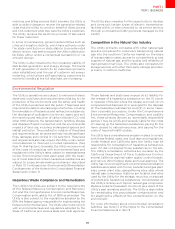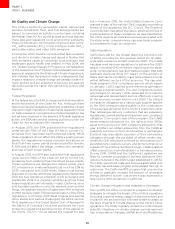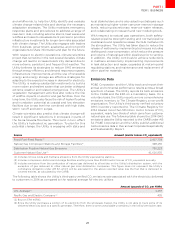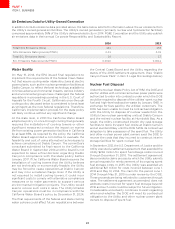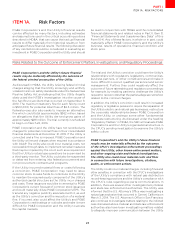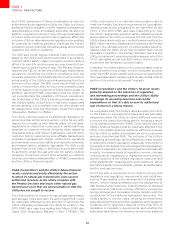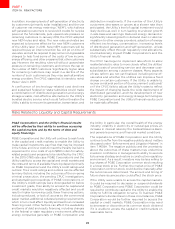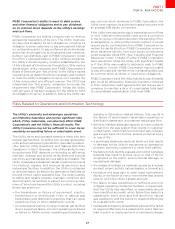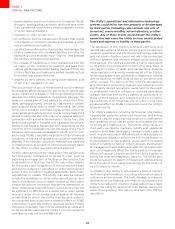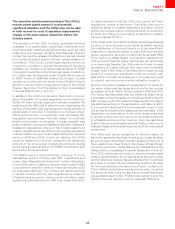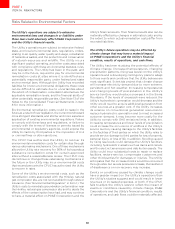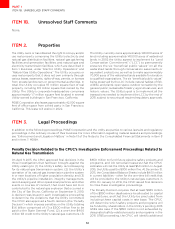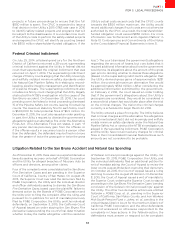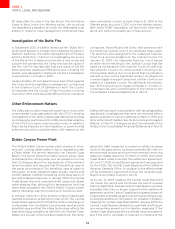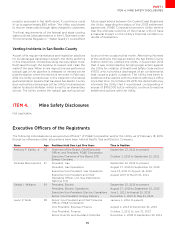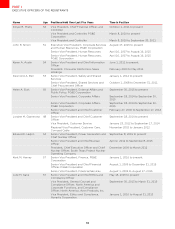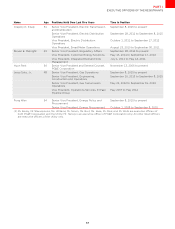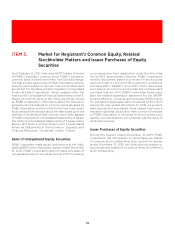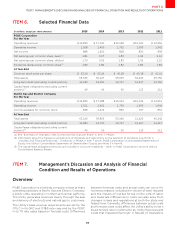PG&E 2015 Annual Report Download - page 37
Download and view the complete annual report
Please find page 37 of the 2015 PG&E annual report below. You can navigate through the pages in the report by either clicking on the pages listed below, or by using the keyword search tool below to find specific information within the annual report.
29
PART I
ITEM 1A.RISK FACTORS
The operation and decommissioning of the Utility’s
nuclear power plants expose it to potentially
significant liabilities and the Utility may not be able
to fully recover its costs if regulatory requirements
change or the plant ceases operations before the
licenses expire.
The operation of the Utility’s nuclear generation facilities
exposes it to potentially significant liabilities from
environmental, health and financial risks, such as risks
relating to the storage, handling and disposal of spent
nuclear fuel, and the release of radioactive materials caused
by a nuclear accident, seismic activity, natural disaster, or
terrorist act. If the Utility incurs losses that are either not
covered by insurance or exceed the amount of insurance
available, such losses could have a material eect on PG&E
Corporation’s and the Utility’s financial results. In addition,
the Utility may be required under federal law to pay up
to $255 million of liabilities arising out of each nuclear
incident occurring not only at the Utility’s Diablo Canyon
facility but at any other nuclear power plant in the United
States. (See Note 13 of the Notes to the Consolidated
Financial Statements in Item 8.)
In addition, the Utility continues to face public concern
about the safety of nuclear generation and nuclear fuel.
Some of these nuclear opposition groups regularly file
petitions at the NRC and in other forums challenging the
actions of the NRC and urging governmental entities to
adopt laws or policies in opposition to nuclear power.
Although an action in opposition may ultimately fail,
regulatory proceedings may take longer to conclude
and be more costly to complete. It is also possible that
public pressure could grow leading to adverse changes in
legislation, regulations, orders, or their interpretation. As
a result, operations at the Utility’s two nuclear generation
units at Diablo Canyon could cease before the licenses
expire in 2024 and 2025. In such an instance, the Utility
could be required to record a charge for the remaining
amount of its unrecovered investment and such charge
could have a material eect on PG&E Corporation and
the Utility’s financial results.
The Utility has incurred, and may continue to incur,
substantial costs to comply with NRC regulations and
orders. (See “Regulatory Environment” in Item 1. Business.)
If the Utility were unable to recover these costs, PG&E
Corporation’s and the Utility’s financial results could
be materially aected. The Utility may determine that
it cannot comply with the new regulations or orders in
a feasible and economic manner and voluntarily cease
operations; alternatively, the NRC may order the Utility
to cease operations until the Utility can comply with new
regulations, orders, or decisions. The Utility may incur a
material charge if it ceases operations at Diablo Canyon
before the licenses expire in 2024 and 2025. At December
31, 2015, the Utility’s unrecovered investment in Diablo
Canyon was $2.3 billion.
At the state level, the California Water Board has adopted
a policy on once-through cooling that generally requires
the installation of cooling towers or other significant
measures to reduce the impact on marine life from existing
power generation facilities in California by at least 85%.
If the California Water Board requires the installation of
cooling towers that the Utility believes are not technically
or economically feasible, the Utility may be forced to cease
operations at Diablo Canyon and may incur a material
charge. Even if the Utility is not required to install cooling
towers, it could incur significant costs to comply with
alternative compliances measures or to make payments
to support various environmental mitigation projects.
Further, the Utility’s leases of coastal land occupied by
the water intake and discharge structures for the nuclear
generation units at Diablo Canyon expire in 2018 and 2019.
The Utility has requested that the California State Lands
Commission renew the leases until 2024 and 2025 when the
NRC licenses expire. The California State Lands Commission
has deferred acting on the application until later in 2016.
It is uncertain what level of environmental review, if any,
will be required before the leases can be extended. If the
leases are not extended or if the Utility determines that
it cannot comply with any new environmental conditions
in a feasible and economic manner, then operations at
Diablo Canyon would cease and the Utility could incur a
material charge for the remaining amount of its unrecovered
investment.
The Utility also has an obligation to decommission its
electricity generation facilities, including its nuclear facilities,
as well as gas transmission system assets, at the end of
their useful lives. (See Note 2: Summary of Significant
Accounting Policies – Asset Retirement Obligations of the
Notes to the Consolidated Financial Statement in Item 8.)
The CPUC authorizes the Utility to recover its estimated
costs to decommission its nuclear facilities through nuclear
decommissioning charges that are collected from customers
and held in nuclear decommissioning trusts to be used
for the eventual decommissioning of each nuclear unit.
If the Utility’s actual decommissioning costs, including
the amounts held in the nuclear decommissioning trusts,
exceed estimated costs, PG&E Corporation’s and the
Utility’s financial results could be materially aected.


